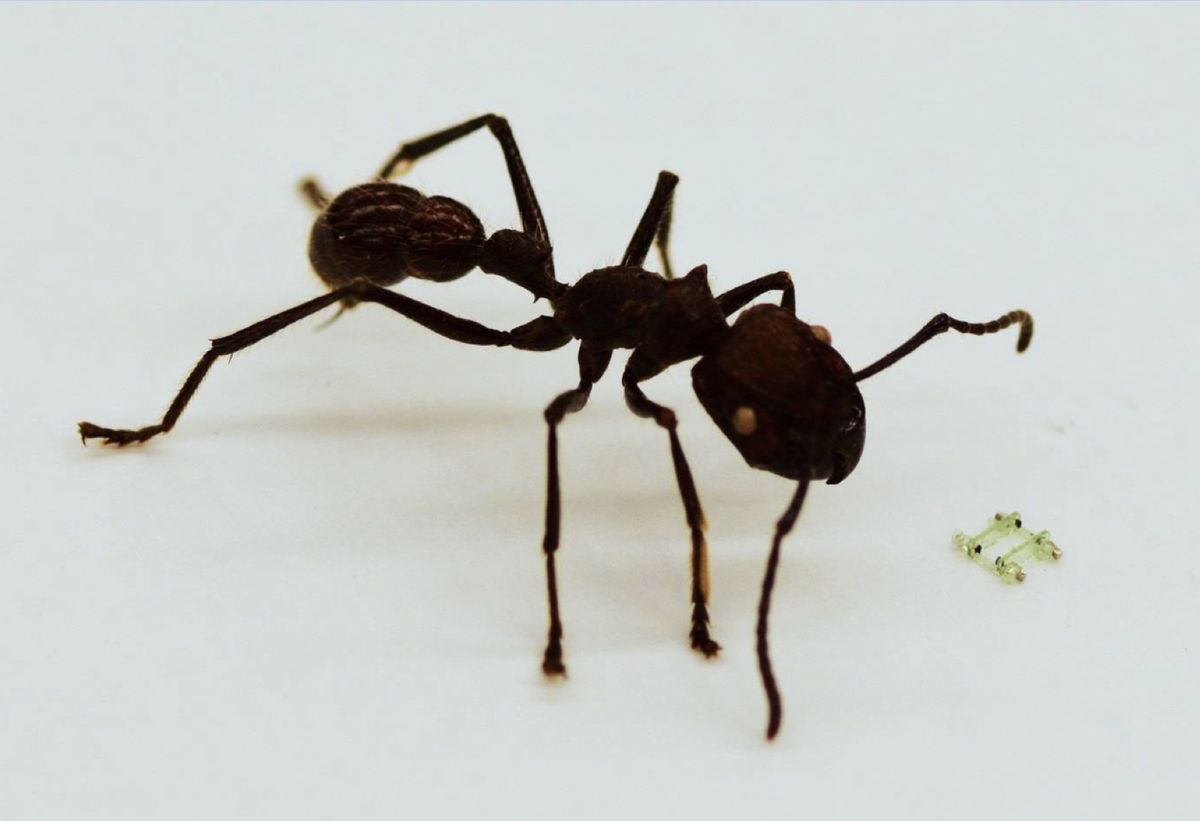A few years ago, we wrote about the tiniest little quadruped robot we’d ever seen—a mere 20 millimeters long, with a hip height of 5.6 mm and weight of about 1.6 gram. The designer, Ryan St. Pierre from Sarah Bergbreiter’s lab at the University of Maryland, also showed us a picture of an even smaller version that weighed just 100 mg. When we saw these things at ICRA 2016, we asked Ryan about going even smaller:
“It’s always a fun challenge to try to make robots as small as possible,” he told us. “Currently, I am working on making a robot, of the same design, that would be 2.5 mm long, an order of magnitude smaller than the ones we presented at ICRA. Smaller robots can more easily go places that larger robots can’t, and having them in various sizes would increase their utility.”
As it turns out, an order of magnitude wasn’t good enough, and instead, St. Pierre developed a quadruped that’s 10 times smaller than that: It weighs just one single milligram, and is smaller than an ant’s head.
Ryan sent us over some videos of the robot operating, although it’s hard to get a sense of how incredibly tiny it actually is. Keep the picture of the robot with the ant in mind for scale—the ant isn’t particularly large itself, just a few centimeters long, and the microrobot measures 2.5 mm x 1.6 mm x 0.7 mm. The design is loosely based on rotary legged robots like RHex, which has a mass more than a million times bigger than the microquad.
Like its predecessors, this robot is far too small for traditional motors or electronics. Its legs are controlled by external magnetic fields acting on tiny cubic magnets embedded in the robot’s hips. Rotating magnetic fields cause the magnets to rotate, driving the legs at speeds of up to 150 Hz. With all of the magnets installed into the hips in the same orientation, you get a proking gait, but other gaits are possible by shifting the magnets around a bit. Top speed is an impressive 37.3 mm/s, or 14.9 body lengths per second, and somewhat surprisingly, the robot seems to be quite durable—it was tested for 1,000,000 actuation cycles “with no signs of visible wear or decreased performance.”
For more details, including about how robots like these might actually be useful, we spoke with Ryan St. Pierre via email.
IEEE Spectrum: How do your robots compare to other very small scale legged robots?
Ryan St. Pierre: [This paper presented] one of the smallest and fastest microrobots that use legs to locomote. There are other microrobots that are smaller, but generally do not use legs as the locomotion method. This work also builds toward an understanding of the dynamics of locomotion at the milligram size scale, in both robots and biology.

The paper says that the orientation of magnets in the legs resulted in a pronking gait. Why choose this gait, and what would be the potential benefits of different gaits?
The gait can be programmed mechanically by choosing the orientation of the magnets relative to each other. Initially I did the pronking gait, with all four magnets in the same direction, to make hand assembly and placement of the magnets easier. In later iterations, I used a trotting gait, with diagonal magnets oriented similarly. Gait ends up being an important choice when it comes to running on smooth and rough terrains and may even require a change of gait when encountering different terrain, something that is not currently available with magnetic actuation.
What are some potential applications for quadrupeds of this size?
The most immediate application of this work is to understand the dynamics of legged locomotion at the milligram scale and have more representative physical and computational models of how ants run. An improved understanding of the fundamental principles of milligram scale locomotion will ultimately inform design and control of autonomous robots at these small size scales.
Is it possible to go even smaller? What would be the benefits and challenges?
It’s certainly possible to go smaller. It depends on available fabrication technology for both the magnetic material and the robot body. Going smaller and using the same type of legs and actuation comes with challenges. First, the friction forces in the joints will dominate, requiring even more torque to spin the legs, making movement less efficient. That being said, going smaller than the current size of 1 mg may ultimately require a change in locomotion strategy. But going smaller and keeping the same design and actuation technique will also give insight into the scaling of terrestrial legged locomotion, unlocking fundamental limits of locomotion, and potentially informing evolutionary pressures in biological systems.
I will admit to being slightly disappointed that there are no immediate plans to send these little robots into our bodies to run around and fix stuff, but their near-term goals of figuring out how legged robots can usefully move at small scales could be a whole bunch of very tiny steps in that direction.
“A 3D-Printed 1-mg Legged Microrobot Running at 15 Body Lengths per Second,” by Ryan St. Pierre, Walker Gosrich, and Sarah Bergbreiter from the University of Maryland (now at Carnegie Mellon University), was presented at the 2018 Hilton Head Solid-State Sensors, Actuators and Microsystems Workshop, where it won the Best Paper Award.
Evan Ackerman is a senior editor at IEEE Spectrum. Since 2007, he has written over 6,000 articles on robotics and technology. He has a degree in Martian geology and is excellent at playing bagpipes.



